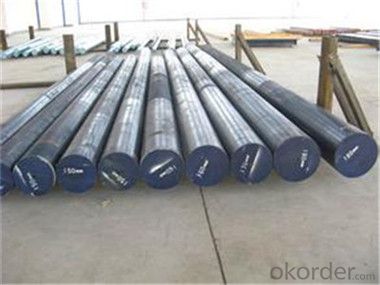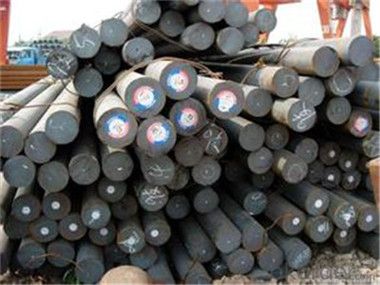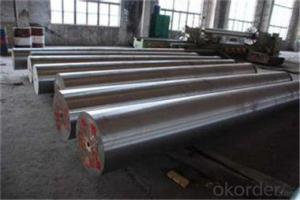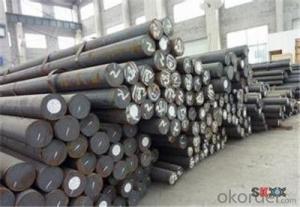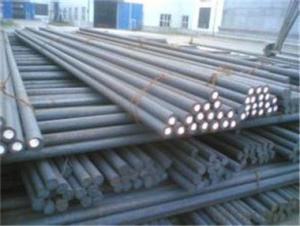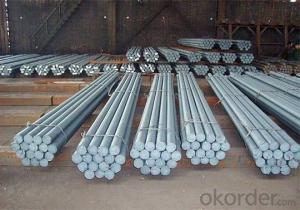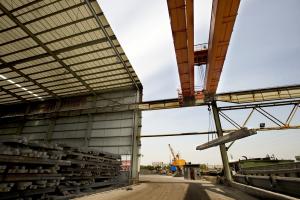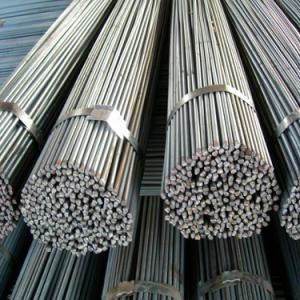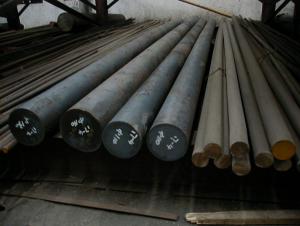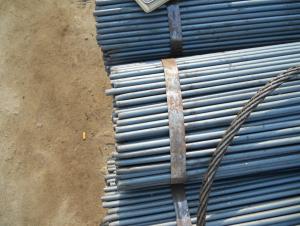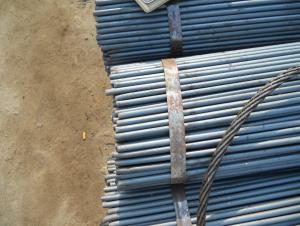Steel Round Bar Reliable Manufacturer with High Quality
- Loading Port:
- Tianjin
- Payment Terms:
- TT OR LC
- Min Order Qty:
- 55 m.t.
- Supply Capability:
- 2000000 m.t./month
OKorder Service Pledge
OKorder Financial Service
You Might Also Like
Description of steel round bar:
1.Diameter 80 to 800 mm
2.Black or Bright surface
3.Annealed or Quenched and tempered provided
4.Cutting service provide
This steel has good workability,processing deformation is small, anti fatigue performance is quite good, belongs to medium quenching steel,4140 after heat treatment, it has good strength and good comprehensive mechanical properties.The process is good.
Festures of steel round bar:
4340 Forged Round Steel Bar
1.Dia 80-800mm Length:2000-13000mm or as required
2.Technique:Forged
3.Delivery Time:45 days
Specifications of steel round bar:
1. Standards: AISI 4340 8620 8640 4320 , JIS SNCM8 GB:40CrNiMoA
2. Specification: Dia: 80~450mm Length:2000-13000mm or as required
3. Process: EAF+LF+VD ( necessary) UT+ Peeled +Turned + Heat Treatment (optional)
Images of coffee machine:

FAQ:
1. What is your package?
Packing situation: standard seaworthy packing or as customer required.
2. How long is the lead time?
Delivery time: 45 days after order confirmed.
3. What payment term do you accept?
Payment: T/T or L/C at sight.
- Q: What is the resistance to fatigue of a steel round bar?
- The resistance to fatigue of a steel round bar refers to its ability to withstand repeated loading and unloading cycles without experiencing failure or deformation. Fatigue resistance is an essential mechanical property for materials used in various applications, including structural components, machinery, and automotive parts. The resistance to fatigue of a steel round bar depends on several factors, including the specific grade of steel, its microstructure, surface condition, and the applied loading conditions. Steel is generally known for its excellent fatigue resistance compared to other materials, which is one of the reasons for its widespread use in various industries. Steel's resistance to fatigue can be attributed to its high strength, ductility, and the presence of various alloying elements. These factors allow steel to withstand cyclic loading without undergoing significant deformation or weakening. Additionally, the microstructure of the steel, such as grain size and distribution, also plays a crucial role in determining its fatigue resistance. To evaluate the fatigue resistance of a steel round bar, engineers typically perform fatigue tests, such as the rotating beam or axial loading tests. These tests involve subjecting the steel bar to controlled cyclic loading and measuring the number of cycles it can withstand before failure occurs. The results of these tests are used to determine the fatigue strength or fatigue limit of the steel, which represents the maximum stress level it can endure indefinitely without failure. It is important to note that the fatigue resistance of a steel round bar can vary depending on factors such as surface defects, stress concentration, and environmental conditions. Therefore, proper design considerations, such as surface treatments, stress reduction techniques, and appropriate loading specifications, are essential to ensure the desired fatigue performance of the steel round bar in specific applications.
- Q: How do steel round bars compare to other materials like aluminum or stainless steel?
- Steel round bars possess numerous advantages over alternative materials such as aluminum or stainless steel. Firstly, their exceptional strength and durability are widely acknowledged. With a high tensile strength, they are capable of enduring heavy loads and extreme conditions, making them ideal for construction, manufacturing, and engineering applications where strength and resilience are vital. When compared to aluminum, steel round bars exhibit superior strength and hardness. Although aluminum is lightweight, it lacks the same level of strength as steel, which can restrict its use in certain applications. Furthermore, steel round bars offer increased resistance to impact and abrasion, making them more suitable for heavy-duty applications that necessitate resistance to wear and tear. Regarding stainless steel, it is essential to note that it is an alloy that primarily contains steel. Stainless steel is renowned for its corrosion resistance, making it an excellent choice for applications exposed to moisture or harsh environments. However, stainless steel does not possess the same strength as steel round bars. Steel round bars excel in carrying heavier loads and providing superior structural integrity. Another crucial aspect to consider is the cost-effectiveness of steel round bars compared to aluminum or stainless steel. Generally, steel is more affordable than stainless steel and aluminum, making it a popular choice across a broad range of applications. Additionally, steel round bars are readily available in various sizes and grades, offering versatility and ease of use. In conclusion, steel round bars outperform alternative materials like aluminum or stainless steel in terms of strength, durability, and cost-effectiveness. However, the ultimate choice of material depends on the specific requirements of the application and the desired properties necessary for the project.
- Q: How are steel round bars measured and specified?
- Steel round bars are measured and specified based on their diameter. The diameter of a round bar is typically measured in millimeters (mm) or inches (in). The measurement is taken across the widest point of the circular cross-section. In terms of specification, steel round bars are commonly specified by their diameter and length. For example, a specification for a steel round bar may be written as "25mm diameter x 3 meters length". This means that the bar has a diameter of 25mm and a length of 3 meters. Additionally, steel round bars may also be specified based on their tolerance, surface finish, and grade. Tolerance refers to the allowable deviation from the specified diameter. Surface finish refers to the quality of the bar's surface, which can range from rough to smooth. Grade refers to the quality and composition of the steel used to make the round bar, such as mild steel, carbon steel, or alloy steel. It is important to accurately measure and specify steel round bars to ensure that they meet the required dimensions and properties for a particular application.
- Q: Can steel round bars be coated or painted?
- Yes, steel round bars can be coated or painted. Coating or painting steel round bars serves several purposes, such as preventing corrosion, enhancing aesthetics, and providing additional protection against environmental factors. Coatings and paints can be applied to steel round bars using various methods, including powder coating, electroplating, or wet paint application. These processes involve preparing the surface of the steel round bar by removing any existing rust or contaminants, followed by the application of the chosen coating or paint. The type of coating or paint used will depend on the specific requirements of the steel round bars, such as the intended use, environmental conditions, and desired appearance. Coating or painting steel round bars can significantly extend their lifespan, improve their visual appeal, and ensure their durability in various applications.
- Q: Can steel round bars be used for gear applications?
- Yes, steel round bars can be used for gear applications. Steel round bars are often used for manufacturing gears due to their high strength, durability, and ability to withstand heavy loads and wear. They can be machined and heat-treated to meet specific gear requirements, making them a suitable choice for various gear applications in industries such as automotive, machinery, and manufacturing.
- Q: What are the different surface defects that can be found in steel round bars?
- Some common surface defects that can be found in steel round bars include scratches, pits, cracks, scale, and decarburization.
- Q: Can steel round bars be used for making handrails?
- Indeed, handrails can be crafted using steel round bars. Owing to their robustness and longevity, steel round bars find widespread usage in construction and fabrication. These bars can be effortlessly molded and joined together through welding techniques, resulting in handrails that furnish support and ensure safety for staircases, balconies, and elevated spaces. Furthermore, steel round bars can be adorned with a variety of coatings or treatments, augmenting their resistance to corrosion and enhancing their visual appeal. In summary, steel round bars are a favored option for fabricating handrails due to their durability, adaptability, and capacity to endure rigorous utilization.
- Q: What are the different types of steel round bar surface treatments?
- Steel round bars can undergo various surface treatments to enhance their appearance, durability, and resistance to corrosion. Some commonly used treatments are: 1. Hot-dip galvanizing: Immerse the steel round bar in molten zinc to create a protective zinc coating, preventing rust and corrosion. Ideal for outdoor applications. 2. Electroplating: Apply a layer of another metal, like chrome or nickel, to the steel round bar. Improves appearance and corrosion resistance. 3. Powder coating: Electrostatically apply a dry powder to the surface, then cure it under heat. Creates a hard, durable, and attractive finish resistant to chipping, scratching, and fading. 4. Passivation: Chemically remove impurities from the surface, leaving a clean and corrosion-resistant layer. Commonly used for enhancing rust resistance in stainless steel bars. 5. Black oxide coating: Form a thin layer of black iron oxide on the surface. Provides mild corrosion resistance and a sleek black appearance. 6. Shot blasting: Propel abrasive materials at high speeds onto the surface to remove impurities or scale. Improves appearance and promotes better coating adhesion. 7. Acid pickling: Immerse the bar in an acid bath to remove scale and impurities, leaving a clean surface free from contaminants. These treatments are just a few examples of what can be done to steel round bars. The choice depends on factors such as the bar's intended use, desired appearance, and required corrosion resistance level.
- Q: What is the difference between a hot rolled and a precision ground steel round bar?
- The main difference between a hot rolled and a precision ground steel round bar is the manufacturing process and the resulting surface finish. Hot rolled steel round bars are made by heating a steel billet until it is soft enough to be formed into a round shape, then rolling it through a series of rollers to achieve the desired diameter. This process creates a rougher surface finish and can result in slight variations in diameter along the length of the bar. On the other hand, precision ground steel round bars are made by starting with a hot rolled bar and then subjecting it to additional grinding or machining processes to achieve a precise diameter and a smooth, consistent surface finish. This extra processing ensures that the bar has a more uniform size and a finer surface texture, making it suitable for applications that require tight tolerances and a polished appearance. Overall, the choice between a hot rolled and a precision ground steel round bar depends on the specific requirements of the application. Hot rolled bars are generally more cost-effective and suitable for less demanding applications, while precision ground bars are preferred for precision machining and high-performance applications.
- Q: Is round bar steel?
- In actual engineering, it is not necessary to use steel bar instead of round steel, but it should not be reversed. In addition, the diameter of the round steel bar is generally not large, but the diameter of the round bar is very large.
Send your message to us
Steel Round Bar Reliable Manufacturer with High Quality
- Loading Port:
- Tianjin
- Payment Terms:
- TT OR LC
- Min Order Qty:
- 55 m.t.
- Supply Capability:
- 2000000 m.t./month
OKorder Service Pledge
OKorder Financial Service
Similar products
Hot products
Hot Searches
Related keywords




